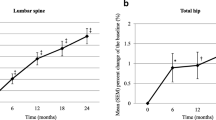Abstract
A 70-year-old female patient was admitted for close examination and treatment of hypercalcemia (corrected serum calcium levels: 3.04 mmol/L) and renal dysfunction (serum creatinine levels: 254.59 µmol/L). The patient had a history of sarcoidosis, diagnosed based on epithelioid cell granulomas in subcutaneous nodule biopsies, uveitis, and bilateral hilar lymphadenopathy, which had spontaneously remitted 10 years before admission. Because the patient was diagnosed with hypercalcemia associated with recurrent sarcoidosis, prednisone (20 mg/day) was initiated, and its dose was tapered following the decrease in serum calcium and creatinine levels. However, the levels of these parameters increased again when the prednisone dose was reduced to ≤ 4 mg/day. We were concerned about glucocorticoid-induced osteoporosis in the patient but hesitated to use first-line bisphosphonates because of renal dysfunction. Therefore, denosumab was initiated to reduce the risk of hypercalcemia, renal dysfunction, and glucocorticoid-induced osteoporosis. Serum creatinine and corrected serum calcium levels subsequently decreased. The prednisone dose could be reduced following repeated denosumab administration.
Thus, denosumab can be a multifaceted, beneficial option for sarcoidosis-induced hypercalcemia, as it alleviates renal dysfunction indirectly by normalizing serum calcium levels, facilitates reduction of the glucocorticoid dose, and ameliorates glucocorticoid-induced osteoporosis.

Similar content being viewed by others
Data Availability
Data are available to academic investigators from the authors upon reasonable request.
References
Hildebrand GK, Kasi A (2022) Denosumab, in: StatPearls [Internet]. StatPearls Publishing, Treasure Island (FL). https://www.ncbi.nlm.nih.gov/books/NBK535388/. Accessed on May 31, 2023
Bone HG, Wagman RB, Brandi ML et al (2017) 10 years of denosumab treatment in postmenopausal women with osteoporosis: results from the phase 3 randomised FREEDOM trial and open-label extension. Lancet Diabetes Endocrinol 5:513–523. https://doi.org/10.1016/S2213-8587(17)30138-9
Nasser SM, Sahal A, Hamad A, Elazzazy S (2019) Effect of denosumab versus zoledronic acid on calcium levels in cancer patients with bone metastasis: a retrospective cohort study. J Oncol Pharm Pract 25:1846–1852. https://doi.org/10.1177/1078155218820927
Torres-Ortiz A, Acharya P, Cheungpasitporn W (2019) Successful treatment of tuberculosis-associated hypercalcemia with denosumab in a patient with acute kidney injury. Ther Apher Dial 23:484–485. https://doi.org/10.1111/1744-9987.12788
Abd Jalil AA, Wan Muhamad Hatta SF, Mohamad AF, Abdul Rani MF (2021) Denosumab as the treatment of recalcitrant tuberculous pleural effusion-associated hypercalcemia. Case Rep Med 2021:5544848. https://doi.org/10.1155/2021/5544848
Alshakh R, Gendi N (2020) EP04 Hypercalcemia of sarcoidosis in a patient with severe renal impairment successfully treated with denosumab. Rheumatology 59(keaa109):003. https://doi.org/10.1093/rheumatology/keaa109.003
Raisz LG, Trummel CL, Holick MF, DeLuca HF (1972) 1,25-Dihydroxycholecalciferol: a potent stimulator of bone resorption in tissue culture. Science 175:768–769. https://doi.org/10.1126/science.175.4023.768
Wong GL, Luben RA, Cohn DV (1977) 1,25-Dihydroxycholecalciferol and parathormone: effects on isolated osteoclast-like and osteoblast-like cells. Science 197:663–665. https://doi.org/10.1126/science.195343
Mori T, Horibe K, Koide M et al (2020) The vitamin D receptor in osteoblast-lineage cells is essential for the proresorptive activity of 1α,25(OH)2D3 in vivo. Endocrinology 161:bqaa178. https://doi.org/10.1210/endocr/bqaa178
Weinstein RS, Chen JR, Powers CC et al (2002) Promotion of osteoclast survival and antagonism of bisphosphonate-induced osteoclast apoptosis by glucocorticoids. J Clin Invest 109:1041–1048. https://doi.org/10.1172/JCI14538
Hahn TJ, Halstead LR, Baran DT (1981) Effects off short term glucocorticoid administration on intestinal calcium absorption and circulating vitamin D metabolite concentrations in man. J Clin Endocrinol Metab 52:111–115. https://doi.org/10.1210/jcem-52-1-111
Suzuki Y, Ichikawa Y, Saito E, Homma M (1983) Importance of increased urinary calcium excretion in the development of secondary hyperparathyroidism of patients under glucocorticoid therapy. Metabolism 32:151–156. https://doi.org/10.1016/0026-0495(83)90221-4
Pearce G, Tabensky DA, Delmas PD, Baker HW, Seeman E (1998) Corticosteroid-induced bone loss in men. J Clin Endocrinol Metab 83:801–806. https://doi.org/10.1210/jcem.83.3.4621
Compston J (2018) Glucocorticoid-induced osteoporosis: an update. Endocrine 61:7–16. https://doi.org/10.1007/s12020-018-1588-2
Horiuchi K, Kobayashi E, Mizuno T, Susa M, Chiba K (2021) Hypercalcemia following discontinuation of denosumab therapy: a systematic review. Bone Rep 15:101148. https://doi.org/10.1016/j.bonr.2021.101148
Dik WA, Heron M (2020) Clinical significance of soluble interleukin-2 receptor measurement in immune-mediated diseases. Neth J Med 78:220–231
Funding
This case report did not receive grants from public, commercial, or not-for-profit funding agencies.
Author information
Authors and Affiliations
Corresponding author
Ethics declarations
Ethics
Written informed consent was obtained from the patient to publish this case report.
Conflict of interests
Naoya Fujita, Yosuke Ono, Kenichi Hashimoto, Yusuke Kawamura, Motohiro Kimata, Akinori Sekizawa, Yasuhiro Obuchi, and Yuji Tanaka declare that they have no conflict of interest.
Additional information
Publisher's Note
Springer Nature remains neutral with regard to jurisdictional claims in published maps and institutional affiliations.
Rights and permissions
Springer Nature or its licensor (e.g. a society or other partner) holds exclusive rights to this article under a publishing agreement with the author(s) or other rightsholder(s); author self-archiving of the accepted manuscript version of this article is solely governed by the terms of such publishing agreement and applicable law.
About this article
Cite this article
Fujita, N., Ono, Y., Hashimoto, K. et al. Efficacy of denosumab in the treatment of hypercalcemic renal dysfunction in sarcoidosis: a case report. Osteoporos Int 35, 733–736 (2024). https://doi.org/10.1007/s00198-023-06998-y
Received:
Accepted:
Published:
Issue Date:
DOI: https://doi.org/10.1007/s00198-023-06998-y




